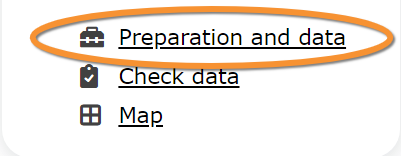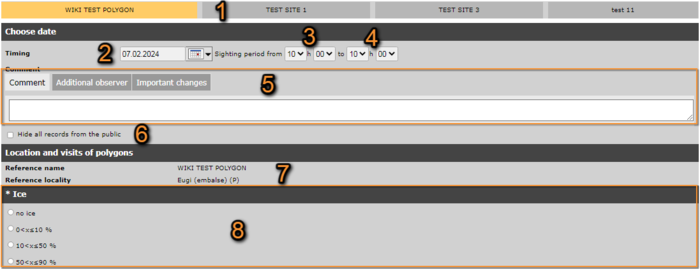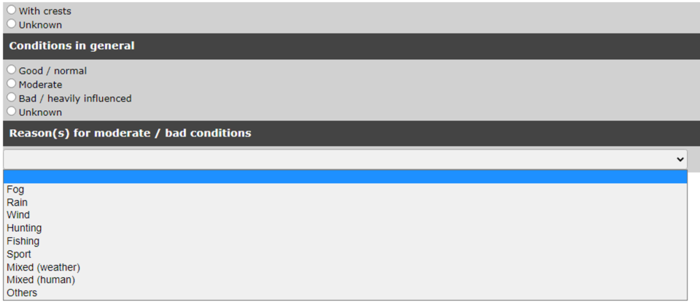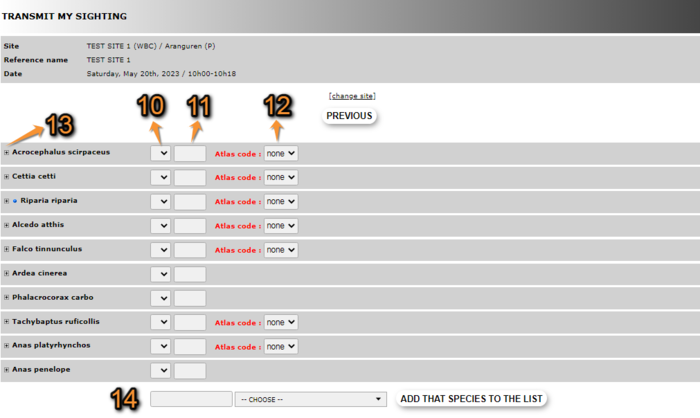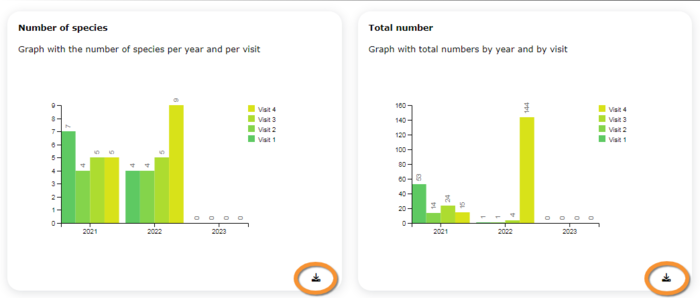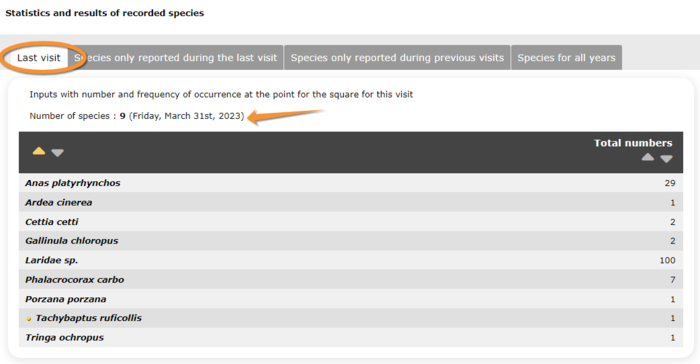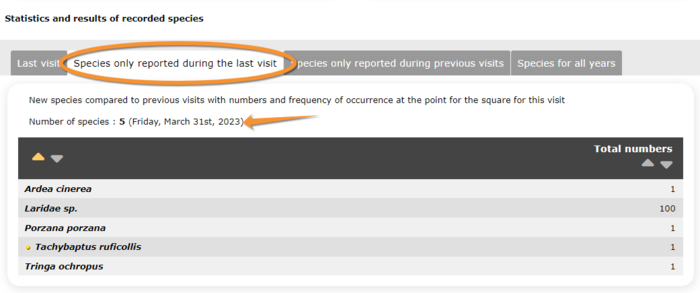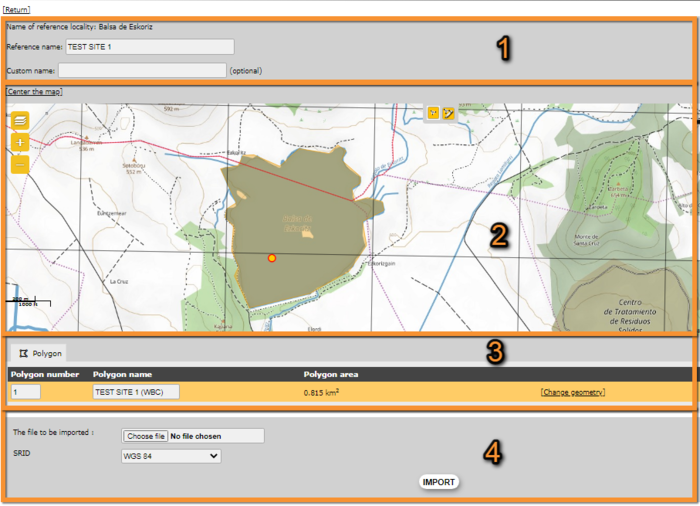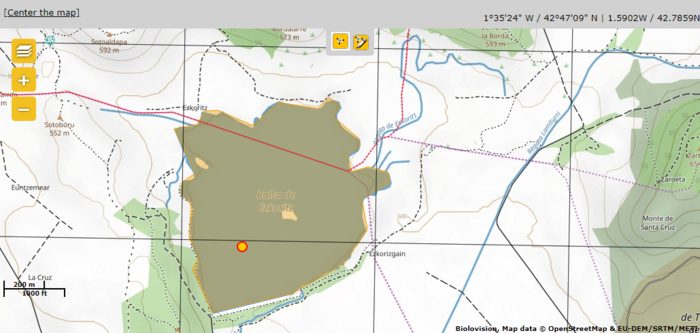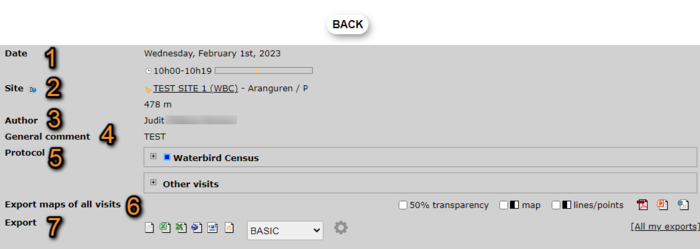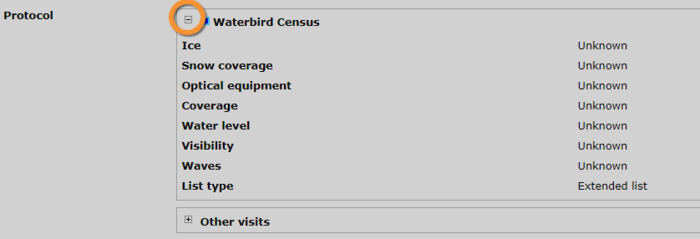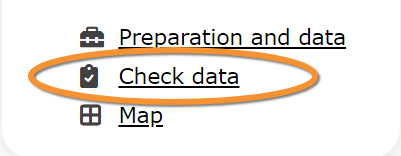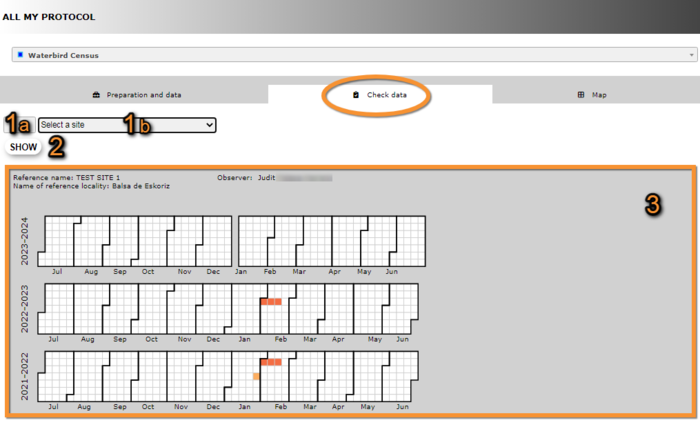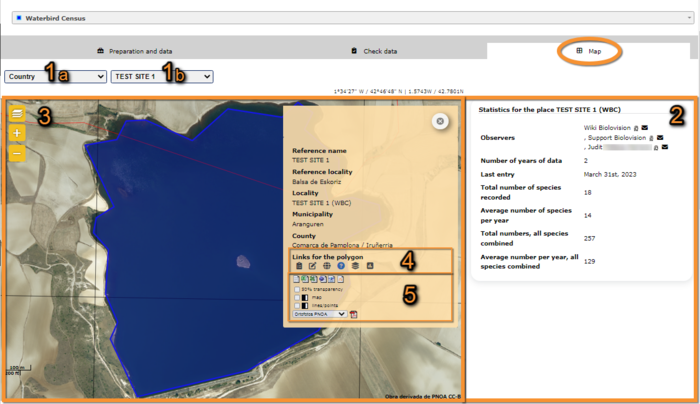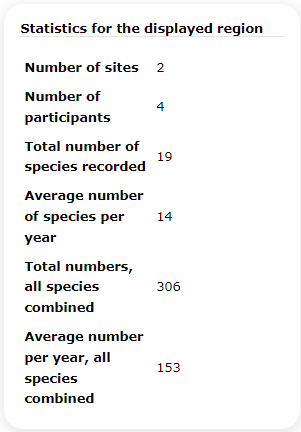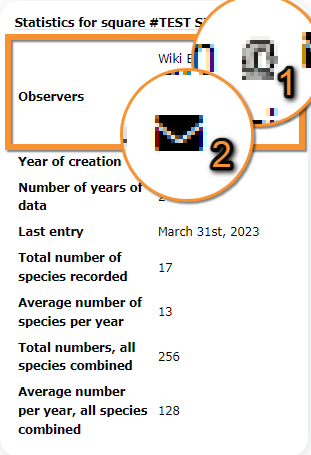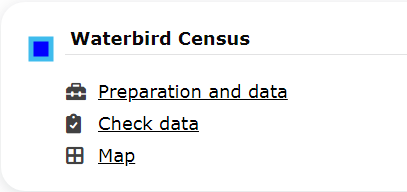Protocols web
Protocols are standardised ways of collecting data linked to a geometry (points, transects or polygons). The methodology to follow depends on the study's goal. A country administrator will grant you access if you meet certain criteria. Not all protocols are available in all countries. See which protocols are available in which country at.... and see which criteria at....
To access your list of protocols, go to Menu > Take part > All my protocols. It lists all protocols you have access to in this local portal (see image below).
|
Menu > Take part > All my protocol. Menu > Taking part > Transmit my sighting > Step 1/3: Approximate choice of a site > By clicking on the map > Create a protocoled census. Menu > Taking part > Transmit my sighting > Step 2/3: Precise site choice > Create a protocoled census. Submit > Transmit my sighting > Step 1/3: Approximate choice of a site > By clicking on the map > Create a protocoled census. Submit > Transmit my sighting > Step 2/3: Precise site choice > Create a protocoled census. |
|
1 Preparation and data 1.1 Add observations 1.1.1 Starting the protocol 1.1.2 Entering observations 1.1.3 Ending the protocol 1.2 Results 1.2.1 Graph 1.2.2 Statistics and results of recorded species 1.3 Display on map 1.5 Census results 1.5.1 Protocol section 1.5.2 Observations section 1.6 Download map
|
Preparation and data
Lists all sites available to the current profile and allows entering observations, downloading printable maps and seeing results.
1. Change protocol by clicking on the active protocol name and selecting from the expandable menu.
2. Move to other sections within the protocol by selecting from the tabs above.
3. List of all sites you have access to under the selected protocol (number 1). When you do not have access to any site under the selected protocol, you will see a message "no count available".
|
1 Preparation and data 1.1 Add observations 1.1.1 Starting the protocol 1.1.2 Entering observations 1.1.3 Ending the protocol 1.2 Results 1.2.1 Graph 1.2.2 Statistics and results of recorded species 1.3 Display on map 1.5 Census results 1.5.1 Protocol section 1.5.2 Observations section 1.6 Download map |
Add observations
Click on Add observations (see image below) in the site you need to enter data to.
Starting the protocol
Before entering observations, it is required to enter general parameters regarding the protocol. Fields marked with an asterisk are mandatory.
- 1. Select site
If necessary, change site by selecting from the tabs. The active site is highlighted in yellow.
- 2. Enter date
Choose from the expandable menu the date the survey took place.
- 3. Enter starting time
Enter the time the census started selecting from the expandable fields.
- 4. Ending time
Enter the time the census ended selecting from the expandable fields.
- 5. Enter comments
Choose one option from the tabs on top (5a) and type a comment (5b). Note the number of tabs and the information required may differ from country to country:
- Comment: if the comment will refer to a general observation,
- Additional observer: if you name other observer/s participating in the census, or
- Important changes: to note important changes from your previous visit, like noise, pollution or construction work.
- Comment: if the comment will refer to a general observation,
- 6. Hide all records from the public
Check if you do not want other users to see your records.
- 7. Parameters
Enter parameters required for your polygon. Note fields and the order in which they appear may differ from country to country. You may not encounter all possible fields described underneath.
- Comment: You may enter a comment if you find it appropiate.
- Comment: You may enter a comment if you find it appropiate.
- Important changes: Indicate if there have been major changes since your last visit.
- Important changes: Indicate if there have been major changes since your last visit.
- Additional observer: Indicate if you are accompanied by someone whose observations are also recorded.
- Additional observer: Indicate if you are accompanied by someone whose observations are also recorded.
- Ice: Indicate the percentatge of water surface that is frozen.
- Ice: Indicate the percentatge of water surface that is frozen.
- Snow coverage: Indicate the proportion of snow cover.
- Snow coverage: Indicate the proportion of snow cover.
- Count type: Tick roost count if you are counting roosting birds, or during day otherwise.
- Count type: Tick roost count if you are counting roosting birds, or during day otherwise.
- Count method: Indicate if you are surveying from the ground, the air, the water, a different way, or if it is unknown.
- Count method: Indicate if you are surveying from the ground, the air, the water, a different way, or if it is unknown.
- Optical equipment: Indicate which equipment you are using for the survey, if any. Note you can only choose one option.
- Optical equipment: Indicate which equipment you are using for the survey, if any. Note you can only choose one option.
- Coverage: Indicate how much of the designated polygon is covered in the survey.
- Coverage: Indicate how much of the designated polygon is covered in the survey.
- Water level: Indicate the water level.
- Water level: Indicate the water level.
- Visibility: Indicate the approximate distance within which it is possible to identify species.
- Visibility: Indicate the approximate distance within which it is possible to identify species.
- Waves: Indicate how are the waves.
- Waves: Indicate how are the waves.
- Conditions in general: Choose how are surveying conditions overall regarding weather and disturbances, and indicate on next section the reason if surveying conditions are not good.
- Conditions in general: Choose how are surveying conditions overall regarding weather and disturbances, and indicate on next section the reason if surveying conditions are not good.
- Reason(s) for moderate / bad conditions: If general conditions indicated above are noot good, open the expandable menu and choose the reason (see image below). Only one option is possible: choose the one that better adjusts to reality.
- Reason(s) for moderate / bad conditions: If general conditions indicated above are noot good, open the expandable menu and choose the reason (see image below). Only one option is possible: choose the one that better adjusts to reality.
- Count payed: Indicate if the count is payed for or not.
- Count payed: Indicate if the count is payed for or not.
- Number of persons on shore: Enter number.
- Number of persons on shore: Enter number.
- Number of rowing boats: Enter number.
- Number of rowing boats: Enter number.
- Number of motor boats: Enter number
- Number of motor boats: Enter number
- Number of sailing boats: Enter number
- Number of sailing boats: Enter number
- Number of canoes/kayaks: Enter number.
- Number of canoes/kayaks: Enter number.
- Number of fishing boats: Enter number.
- Number of fishing boats: Enter number.
- Number of sports divers: Enter number.
- Number of sports divers: Enter number.
- Number of surfers: Enter number.
- Number of surfers: Enter number.
- 7. No species were seen
Check if your survey did not provide any data. Surveys with no species are also important results! It will mean you followed the established methodology, and therefore your survey is valid, but no birds were present. They can indicate major population changes and are of extreme importance for conservation purposes.
- 8. Continue with the basic list
Select to load a species list strictly related to the protocol (ie. waterbirds). It will facilitate entering data. See an example of how it may look like in image Example of a basic list compared to an Example of extended list. Which species belong to a basic list is determined by each local portal and may differ from one to another.
If no list appears means that no pre registered species list exist, just enter your data as usual.
- 9. Continue with the extended list
Select to load a species list strictly related to the protocol (ie. waterbirds) along with other related ones (ie. reed-living species). It will facilitate entering data. See an example of how it may look like in image Example of extended list. Species included in a basic list and an extended list are determined by each local portal and may differ from country to country.
If no list appears means that no pre registered species list exist, just enter your data as usual.
|
Surveys with no species are also important results! Please submit them. It will mean you followed the established methodology but no birds were present. It can be due to methodology, disturbance, pollution or other major population changes and may be of extreme importance for conservation purposes. |
Entering observations
Enter observations as if entering a list. See wiki section Web interface > Submitting records > Step 3/3: Transmit my sighting > If accessed from a list> List section if further information is needed.
If your portal provided you with a basci or extended species list, use it to facilitate entering observations.
Change site: change site to enter observations at. You will have to re-enter all parameters again.
Previos: return to previous page without saving.
- 10. Count precision
- 10. Count precision
Choose from the expandable menu count precision. See correspondence of symbols at...
- 11. Number of individuals
- 11. Number of individuals
Type number of individuals.
- 12. Atlas code
- 12. Atlas code
When available, select from the expandable menu the corresponding atlas code.
- 13. Additional information
- 13. Additional information
Click on the + sign to open the additional information form, and fill as described in wiki section Web interface > Take part: Submitting records > Step 3/3:Transmit my sighting > If accessed from a list (fill a daily form) > Aditional information.
- 14. Other species
- 14. Other species
If you want to report a species not in the list, enter as usual: type the name of the species, or part of it, in the left hand field, select from the expandable menu on its right and click on add that species to the list to save the record. When in the list, indicate number of individuals, atlas code and additional information as previously described.
Ending the protocol
When all species are recorded, indicate
- 1. I recorded all species of the programme if you identified and recorded all species seen or heard that are of interest to the Waterbird Census protocol, or
- 2. I recorded all species (=full observation lis) if besides all species of interest to the protocol, you also identified and recorded all other species seen or heard. Note you can only record in this list species identified wihtin the designated polygon. Any species recorded outside of the polygon should be submitted as an individual record.
You will be taken to set parameters to start a new protocol.
Results
See some statistics about your surveys results.
Graphs
- Number of species
Represents the number of spcies recorded in each visit.
From the example in the image above, the user recorded 7 species during the first visit of 2021, 4 on the second visit, and 5 on each of the last two. Equally, no species were recorded in any of the 4 visits of 2023.
Click on the download icon (encircled in picture) to download the data as a .CVS file, that can be uploaded into R software.
- Total number
Represents the number of individuals recorded in each visit, pulling all species together.
From the example in the image above, the user recorded 53 individuals on the first visit of 2021, 14 on the second and so on, and none in any of the viists of 2023.
Click on the download icon (encircled in picture) to download the data as a .CVS file, that can be uploaded into R software.
Statistics and results of recorded species
- Last visit
List of species recorded at the selected site during the last visit. Use arrows under titles to alternate between ascending and descending order (see image as an example). Orange arrow in image indicates the date of last visit.
Total number: Total number of individuals of the selected species recorded on the last visit only.
- Species only reported during the last visit
List of species recorded only during the last visit and not in any other visit. Use arrows under titles to alternate between ascending and descending order (see image as an example). Orange arrow in image indicates the date of last visit.
Total number: Number of individuals of the selected species recorded on the last visit.
- Species only reported during previous visits
List of species that were not reported during the last visit but were seen in any of the previous ones. Use arrows under titles to alternate between ascending and descending order (see image as an example). Orange arrow in image indicates the date of last visit.
Last date: Last date the selected species was recorded.
Total numbers: Number of individuals recorded on the last date the species was seen.
- Species for all years
List of all species reported by the user at this site, and the frequency of occurence. Use arrows under titles to alternate between ascending and descending order (see image as an example). Orange arrow in image indicates the date of last visit.
Average frequence of occurrence: Proportion of visits in which the species was recorded.
For example, Anas platyrhynchos has been recorded in all visits at this site, Anas clypeata has only been recorded in half of them, and Anas acuta only in a 12.5% of them.
Total numbers: Total number of recordings for the species across all visits and years for the site.
Display on map
For the selected site, see the polygon to survey on a map. To know how to navigate the map, refer to wiki section Web interface > Navigating the map.
Modify the protocol
Modify the polygon to survey.
Return: Go to previous screen without saving.
Center the map: Center the map on the polygon.
- 1. Modify name
Add or amend polygon custom name. Polygon reference name can only be changed by administrators.
Name of reference locality: Location under which all objects from the protocol are attached to. It is determined by administrators when creating the site and cannot be changed afterwards.
Reference name: Polygon name officially defined for the protocol, can be a number, name or any other code.
Custom name: name under which the site amy also be known or name the user that do the census want to give to his site.
- 2. Modify polygon
Change the shape of the polygon. See Web interface > Navigating the map to know how to move around the map, and ... to know how to draw or modify a polygon.
Center the map: Centers the map to the site polygon.
- 3. Download polygon
Dowload the polygon as a shapefile, to use in the future or to modify it.
Polygon number: indicates the polygon the entry represents in sites with more than one polygon.
Polygon name: site name.
Polygon area: area of the polygon.
5. Change geometry: Click to upload a new shapefile. It will open a menu identical to next subsection (see image).
6. Export: Click on the icon to download the corresponding polygon as a shapefile. Modify it on a GIS and upload (see next subsection to upload).
- 4. Upload polygon
Import an existing polygon.
The file to be imported: Click on Choose file to select the polygon from your computer. The file name will be displayed next to the button.
SRID: Choose from the expandable menu the Datum the imported shapefile is on.
IMPORT: Click to upload the polygon.
Census results
Click on Census results to see all available years with data for this site (see image below). Select the one to visualise.
Sites with no records do not appear on the menu. You can only see your own records, unless you are a protocol administrator. To know more about administrators, see wiki section Administration.
A new window will show all your records at the selected site. A grey section on top contains general information about this particular count, while the bottom part refers to the observations.
Protocol section
General information about the selected visit at the selected site.
BACK: Go to previous screen.
- 1. Date
Date and time of selected survey. Notice the bar representing the extent of the day, and the yellow marking indicating time of day the survey took place (see image Time of survey).
- 2. Site
Site of selected survey.
8. Click on site name to open a new window with more information about the site, and its map.
9. Altitude.
10. Click on icon to access all observations associated with the site as in the Search engine. See wiki section ... to know more about the Search engine function.
- 3. Author
Name of observer. If you are an administrator, click on name to access their personal card.
- 4. General comment
Comment about the selected survey.
- 5. Protocol
- 11. Click on the + sign to expand the panel, and on the - sign to collapse when opened (encircled on image below). It summarises protocol parameters for this visit (see image below).
- 11. Click on the + sign to expand the panel, and on the - sign to collapse when opened (encircled on image below). It summarises protocol parameters for this visit (see image below).
- 12. Click on the + sign to expand the panel, and on the - sign to collapse when opened (encircled on image below). It lists all visits (see image below).
- 12. Click on the + sign to expand the panel, and on the - sign to collapse when opened (encircled on image below). It lists all visits (see image below).
- 6. Export maps of all visits
- 7. Export
Observations section
- 1. Visits
List of al visits to the site for the selected period. Use the bar on the right to see all visits if necessary.
4. Select from the expandable menu a different period if necessary.
5. Select the visit you would like to visualise. The selected visit will be highlighted in grey. Note the data next to the visit number.
6. Click on notebook icon to modify / visualise the selected visit. If necessary, modify as described in wiki section Web interface > Editing records > From the right hand column > Modify a record from a list.
- 2. Species
List of species recorded on the selected visit to this site. If necessary, move the right hand bar to see the full list. See wiki section Various > Symbols cheatsheet to know correspondence of symbols next to species names.
If your observations were submitted through the website, records are associated to a protocol polygon but their precise location within the polygon is unknown. No observations will be displayed in the map (see image Waterbird census protocol. Browsing visits as an example).
If your observations were submitted through NaturaList, records are displayed on the map on their precise location within the polygon (see image Waterbird census protocol. Records visualisation on the map. as an example).
|
|
- 3. Map
See the polygon of the surveyed site and all observations for the selected visit, if they were submitted through NaturaList. To know how to navigate the map, visit wiki section Web interface > Navigating the map.
To better visualise observations, select a species from the Observed species section left of the map (see sub-section 2. Species above). All records of the selected species are displayed in red, while all others continue being displayed in yellow.
7. Summary of observations
Details associated to the selected observation are summarised next to its position (represented by a red dot). To see how to interpret it, refer to wiki section Mobile interface > Understanding a summary of observations.
8. Hide / Unhide
Click an icon to hide or unhide records. When hidden, only those refering to the selected species (red dots) will be visible.
9. Zoom
Select to zoom and center observations. Choose between
Zoom on all records of the species to see and center all records of the selected species.
Zoom on all records to see and center all records of this visit. When selected this option, all records will be displayed even when they were previously hidden.
10. Add a species in the form
Add a new entry to the selected visit. Enter information as for a list. See wiki section Web interface > Submitting records > Step 3/3: Submit my sighting > As if accessed from a list > List section.
Download map
Donload maps ready to print.
50% transparency: Check to print the map with 50% of transparency (see image Example 50% transparency, default map on top, transparent map below).
Map: Check to print the map in black and white (see image Example black and white, default map on top, black and white below).
Lines/points: Check to delimit the polygon to survey with dots instead of lines (see image Example lines and points, map with lines on top (defalut option), with points below).
1. Choose from the expandable menu the map layer you would like to print.
2. Click on pdf icon to download the map as a pdf.
|
|
Check data
Calendar showing visits to diferent sites and number of species detected.
- 1. Select site
Select a site by typing the name, or part of the name, in the left field (1a) and/or selecting from the expandable menu on the right (1b). Click 'Select a site' from the expandable menu to revert the selection and visualise all site again.
- 2. SHOW
Click to apply selection.
- 3. Graphic area
See a calendar with dates in which surveys took place (colored cells). Move pointer on any colored cell to see the date the census took place and the number of species recorded. The darker the colour, the larger number of species.
Click on any coloured cell to see on a new window a list of species recorded on that date. Refer to wiki section Web interface > Codes and symbols to understand the meaning of the different symbols associated to each observation.
Map
Map and statistics for site.
- 1. Select site
Select area on the left hand expandable menu (1a) and/or study site on the right hand menu (1b). 'Country' on the area menu refers to the whole area covered by the local portal you are in.
- 2. Statistics
Basic statitics about the selected area or site/sites.
- Statistics for the displayed region
- Statistics for the displayed region
Statistics when more than one site is included in the selected area. Data from all sites are pooled in the results.
- Statistics for square
- Statistics for square
Statistics when oly one site is included in the search. It includes names of all users involved, and it is possible to contact them (icon 2) and/see all records associated by the user (icon 1).
1. See all observations reported by this user.
2. Email user. It will require Microsoft Outlook. If not installed yet, it will open the installer assitant.
- 3. Map area
Map with the polygons to survey highlighted in pink. Visit wiki section Web interface > Navigating the map to know how to navigate the map.
Select a site on the right hand expandable menu (see 1b) when there is more than one site per area.
Click on the desired polygon to see details (see image below).
- 4. Links for the polygon
- 4. Links for the polygon
- Place the pointer on icons to see the meaning of each of them.
- Add observations: Add further observations to this site or any other as described in wiki section Web interface > Protocols > Preparation and data > Add observations.
- Add observations: Add further observations to this site or any other as described in wiki section Web interface > Protocols > Preparation and data > Add observations.
- Modify the protocol: Modify the protocol as described in wiki section Web > Protocols > Preparation and data > Modify the protocol.
- Modify the protocol: Modify the protocol as described in wiki section Web > Protocols > Preparation and data > Modify the protocol.
- All site data: See all records associated to the site. From this screen (see image below) you can access other data as in the Search engine tool.
- All site data: See all records associated to the site. From this screen (see image below) you can access other data as in the Search engine tool.
- List of records to be checked: See all records associated to the site needing verification.
- List of records to be checked: See all records associated to the site needing verification.
- Data visualisation:
- Data visualisation:
- Results: See results as described in wiki section Web interface > Protocols > Preparation and data > Results.
- Results: See results as described in wiki section Web interface > Protocols > Preparation and data > Results.
- 5. Export
- 5. Export
- Place the pointer on icons to see the meaning of each of them.
Waterbird Protocol (web)
Access your protocol from Menu > Take part > All my protocol and search for the protocol you want to work with. You will be able to download the map to survey, enter data or edit the protocol.
Alternatively, enter data to your protocol as if entering non-protocolled data by clicking on a map or by entering a precise site. Among the options will be those of the projects and protocols you have access to (see image below).
|
Menu > Take part > All my protocol. Menu > Taking part > Transmit my sighting > Step 1/3: Approximate choice of a site > By clicking on the map > Create a protocoled census. Menu > Taking part > Transmit my sighting > Step 2/3: Precise site choice > Create a protocoled census. Submit > Transmit my sighting > Step 1/3: Approximate choice of a site > By clicking on the map > Create a protocoled census. Submit > Transmit my sighting > Step 2/3: Precise site choice > Create a protocoled census. |
|
1 Waterbird census 1.1.1 Add observations 1.1.1.1 Starting the protocol 1.1.1.2 Entering observations 1.1.1.3 Ending the protocol 1.1.2 Results 1.1.2.1 Graph 1.1.2.2 Statistics and results of recorded species 1.1.3 Display on map 1.1.4 Modify the protocol 1.1.5 Census results 1.1.5.1 Protocol section 1.1.5.2 Observations section 1.1.6 Download map 1.2 Check data 1.3 Map |
Preparation and data
Lists all sites available to the current profile and allows entering observations, downloading printable maps and seeing results.
1. Move to other sections within the protocol by selecting from the tabs above.
2. Change protocol by clicking on the active protocol name and selecting from the expandable menu.
|
1.1 Preparation and data 1.1.1 Add observations 1.1.1.1 Starting the protocol 1.1.1.2 Entering observations 1.1.1.3 Ending the protocol 1.1.2 Results 1.1.2.1 Graph 1.1.2.2 Statistics and results of recorded species 1.1.3 Display on map 1.1.4 Modify the protocol 1.1.5 Census results 1.1.5.1 Protocol section 1.1.5.2 Observations section 1.1.6 Download map |
Add observations
Click on Add observations (see image below) in the site you need to enter data to.
Starting the protocol
Before entering observations, it is required to enter general parameters regarding the protocol. Fields marked with an asterisk are mandatory.
- 1. Select site
If necessary, change site by selecting from the tabs. The active site is highlighted in yellow.
- 2. Enter date
Choose from the expandable menu the date the survey took place.
- 3. Enter starting time
Enter the time the census started selecting from the expandable fields.
- 4. Ending time
Enter the time the census ended selecting from the expandable fields.
- 5. Enter comments
Choose one option from the tabs on top (5a) and type a comment (5b). Note the number of tabs and the information required may differ from country to country:
- Comment: if the comment will refer to a general observation,
- Additional observer: if you name other observer/s participating in the census, or
- Important changes: to note important changes from your previous visit, like noise, pollution or construction work.
- Comment: if the comment will refer to a general observation,
- 6. Hide all records from the public
Check if you do not want other users to see your records.
- 7. Parameters
Enter parameters required for your polygon. Note fields and the order in which they appear may differ from country to country. You may not encounter all possible fields described underneath.
- Comment: You may enter a comment if you find it appropiate.
- Comment: You may enter a comment if you find it appropiate.
- Important changes: Indicate if there have been major changes since your last visit.
- Important changes: Indicate if there have been major changes since your last visit.
- Additional observer: Indicate if you are accompanied by someone whose observations are also recorded.
- Additional observer: Indicate if you are accompanied by someone whose observations are also recorded.
- Ice: Indicate the percentatge of water surface that is frozen.
- Ice: Indicate the percentatge of water surface that is frozen.
- Snow coverage: Indicate the proportion of snow cover.
- Snow coverage: Indicate the proportion of snow cover.
- Count type: Tick roost count if you are counting roosting birds, or during day otherwise.
- Count type: Tick roost count if you are counting roosting birds, or during day otherwise.
- Count method: Indicate if you are surveying from the ground, the air, the water, a different way, or if it is unknown.
- Count method: Indicate if you are surveying from the ground, the air, the water, a different way, or if it is unknown.
- Optical equipment: Indicate which equipment you are using for the survey, if any. Note you can only choose one option.
- Optical equipment: Indicate which equipment you are using for the survey, if any. Note you can only choose one option.
- Coverage: Indicate how much of the designated polygon is covered in the survey.
- Coverage: Indicate how much of the designated polygon is covered in the survey.
- Water level: Indicate the water level.
- Water level: Indicate the water level.
- Visibility: Indicate the approximate distance within which it is possible to identify species.
- Visibility: Indicate the approximate distance within which it is possible to identify species.
- Waves: Indicate how are the waves.
- Waves: Indicate how are the waves.
- Conditions in general: Choose how are surveying conditions overall regarding weather and disturbances, and indicate on next section the reason if surveying conditions are not good.
- Conditions in general: Choose how are surveying conditions overall regarding weather and disturbances, and indicate on next section the reason if surveying conditions are not good.
- Reason(s) for moderate / bad conditions: If general conditions indicated above are noot good, open the expandable menu and choose the reason (see image below). Only one option is possible: choose the one that better adjusts to reality.
- Reason(s) for moderate / bad conditions: If general conditions indicated above are noot good, open the expandable menu and choose the reason (see image below). Only one option is possible: choose the one that better adjusts to reality.
- Count payed: Indicate if the count is payed for or not.
- Count payed: Indicate if the count is payed for or not.
- Number of persons on shore: Enter number.
- Number of persons on shore: Enter number.
- Number of rowing boats: Enter number.
- Number of rowing boats: Enter number.
- Number of motor boats: Enter number
- Number of motor boats: Enter number
- Number of sailing boats: Enter number
- Number of sailing boats: Enter number
- Number of canoes/kayaks: Enter number.
- Number of canoes/kayaks: Enter number.
- Number of fishing boats: Enter number.
- Number of fishing boats: Enter number.
- Number of sports divers: Enter number.
- Number of sports divers: Enter number.
- Number of surfers: Enter number.
- Number of surfers: Enter number.
- 7. No species were seen
Check if your survey did not provide any data. Surveys with no species are also important results! It will mean you followed the established methodology, and therefore your survey is valid, but no birds were present. They can indicate major population changes and are of extreme importance for conservation purposes.
- 8. Continue with the basic list
Select to record only the species strictly related to the protocol (ie. ducks). Which species belong to a basic list is determined by each local portal and may differ from one to another.
If no list appears means that no pre registered species list exist, just enter your data as usual.
- 9. Continue with the extended list
Select to enter the species strictly related to the protocol (ie. ducks) along with other related ones (ie. egrets). Species included in a basic list and an extended list are determined by each local portal and may differ from country to country.
If no list appears means that no pre registered species list exist, just enter your data as usual.
|
Surveys with no species are also important results! Please submit them. It will mean you followed the established methodology but no birds were present. It can be due to methodology, disturbance, pollution or other major population changes and may be of extreme importance for conservation purposes. |
Entering observations
Enter observations as if entering a list. See wiki section Web interface > Submitting records > Step 3/3: Transmit my sighting > If accessed from a list> List section if further information is needed.
Ending the protocol
When all species are recorded, indicate
- 1. I recorded all species of the programme if you identified and recorded all species seen or heard that are of interest to the Waterbird Census protocol, or
- 2. I recorded all species (=full observation lis) if besides all species of interest to the protocol, you also identified and recorded all other species seen or heard. Note you can only record in this list species identified wihtin the designated polygon. Any species recorded outside of the polygon should be submitted as an individual record.
You will be taken to set parameters to start a new protocol.
Results
See some statistics about your surveys results.
Graphs
- Number of species
Represents the number of spcies recorded in each visit.
From the example in the image above, the user recorded 7 species during the first visit of 2021, 4 on the second visit, and 5 on each of the last two. Equally, no species were recorded in any of the 4 visits of 2023.
Click on the download icon (encircled in picture) to download the data as a .CVS file, that can be uploaded into R software.
- Total number
Represents the number of individuals recorded in each visit, pulling all species together.
From the example in the image above, the user recorded 53 individuals on the first visit of 2021, 14 on the second and so on, and none in any of the viists of 2023.
Click on the download icon (encircled in picture) to download the data as a .CVS file, that can be uploaded into R software.
Statistics and results of recorded species
- Last visit
List of species recorded at the selected site during the last visit. Use arrows under titles to alternate between ascending and descending order (see image as an example). Orange arrow in image indicates the date of last visit.
Total number: Total number of individuals of the selected species recorded on the last visit only.
- Species only reported during the last visit
List of species recorded only during the last visit and not in any other visit. Use arrows under titles to alternate between ascending and descending order (see image as an example). Orange arrow in image indicates the date of last visit.
Total number: Number of individuals of the selected species recorded on the last visit.
- Species only reported during previous visits
List of species that were not reported during the last visit but were seen in any of the previous ones. Use arrows under titles to alternate between ascending and descending order (see image as an example). Orange arrow in image indicates the date of last visit.
Last date: Last date the selected species was recorded.
Total numbers: Number of individuals recorded on the last date the species was seen.
- Species for all years
List of all species reported by the user at this site, and the frequency of occurence. Use arrows under titles to alternate between ascending and descending order (see image as an example). Orange arrow in image indicates the date of last visit.
Average frequence of occurrence: Proportion of visits in which the species was recorded.
For example, Anas platyrhynchos has been recorded in all visits at this site, Anas clypeata has only been recorded in half of them, and Anas acuta only in a 12.5% of them.
Total numbers: Total number of recordings for the species across all visits and years for the site.
Display on map
For the selected site, see the polygon to survey on a map. To know how to navigate the map, refer to wiki section Web interface > Navigating the map.
Modify the protocol
Modify the polygon to survey.
Return: Go to previous screen without saving.
- 1. Modify name
Amend polygon reference name and/or add or amend polygon custom name.
Reference name: Polygon name officilay defined for the protocol, can be a number, name or any other code.
Custom name: name under which the site amy also be known or name the user that do the census want to give to his site.
- 2. Modify polygon
Change the shape of the polygon. See Web interface > Navigating the map to know how to move around the map, and ... to know how to draw or modify a polygon.
Center the map: Centers the map to the site polygon.
- 3. Download polygon
Dowload the polygon as a shapefile, to use in the future or to modify it.
Polygon number: indicates the polygon the entry represents in sites with more than one polygon.
Polygon name: site name.
Polygon area: area of the polygon.
5. Change geometry: Click to upload a new shapefile. It will open a menu identical to next subsection (see image).
6. Export: Click on the icon to download the corresponding polygon as a shapefile. Modify it on a GIS and upload (see next subsection to upload).
- 4. Upload polygon
Import an existing polygon.
The file to be imported: Click on Choose file to select the polygon from your computer. The file name will be displayed next to the button.
SRID: Choose from the expandable menu the Datum the imported shapefile is on.
IMPORT: Click to upload the polygon.
Census results
Click on Census results to see all available years with data for this site (see image below). Select the one to visualise.
Sites with no records do not appear on the menu. You can only see your own records, unless you are a protocol administrator. To know more about administrators, see wiki section Administration.
A new window will show all your records at the selected site. A grey section on top contains general information about this particular count, while the bottom part refers to the observations.
Protocol section
General information about the selected visit at the selected site.
BACK: Go to previous screen.
- 1. Date
Date and time of selected survey. Notice the bar representing the extent of the day, and the yellow marking indicating time of day the survey took place (see image Time of survey).
- 2. Site
Site of selected survey.
8. Click on site name to open a new window with more information about the site, and its map.
9. Altitude.
10. Click on icon to access all observations associated with the site as in the Search engine. See wiki section ... to know more about the Search engine function.
- 3. Author
Name of observer. If you are an administrator, click on name to access their personal card.
- 4. General comment
Comment about the selected survey.
- 5. Protocol
- 11. Click on the + sign to expand the panel, and on the - sign to collapse when opened (encircled on image below). It summarises protocol parameters for this visit (see image below).
- 11. Click on the + sign to expand the panel, and on the - sign to collapse when opened (encircled on image below). It summarises protocol parameters for this visit (see image below).
- 12. Click on the + sign to expand the panel, and on the - sign to collapse when opened (encircled on image below). It lists all visits (see image below).
- 12. Click on the + sign to expand the panel, and on the - sign to collapse when opened (encircled on image below). It lists all visits (see image below).
- 6. Export maps of all visits
- 7. Export
Observations section
- 1. Visits
List of al visits to the site for the selected period. Use the bar on the right to see all visits if necessary.
4. Select from the expandable menu a different period if necessary.
5. Select the visit you would like to visualise. The selected visit will be highlighted in grey. Note the data next to the visit number.
6. Click on notebook icon to modify / visualise the selected visit. If necessary, modify as described in wiki section Web interface > Editing records > From the right hand column > Modify a record from a list.
- 2. Species
List of species recorded on the selected visit to this site. If necessary, move the right hand bar to see the full list. See wiki section Various > Symbols cheatsheet to know correspondence of symbols next to species names.
If your observations were submitted through the website, records are associated to a protocol polygon but their precise location within the polygon is unknown. No observations will be displayed in the map (see image Waterbird census protocol. Browsing visits as an example).
If your observations were submitted through NaturaList, records are displayed on the map on their precise location within the polygon (see image Waterbird census protocol. Records visualisation on the map. as an example).
|
|
- 3. Map
See the polygon of the surveyed site and all observations for the selected visit, if they were submitted through NaturaList. To know how to navigate the map, visit wiki section Web interface > Navigating the map.
To better visualise observations, select a species from the Observed species section left of the map (see sub-section 2. Species above). All records of the selected species are displayed in red, while all others continue being displayed in yellow.
7. Summary of observations
Details associated to the selected observation are summarised next to its position (represented by a red dot). To see how to interpret it, refer to wiki section Mobile interface > Understanding a summary of observations.
8. Hide / Unhide
Click an icon to hide or unhide records. When hidden, only those refering to the selected species (red dots) will be visible.
9. Zoom
Select to zoom and center observations. Choose between
Zoom on all records of the species to see and center all records of the selected species.
Zoom on all records to see and center all records of this visit. When selected this option, all records will be displayed even when they were previously hidden.
10. Add a species in the form
Add a new entry to the selected visit. Enter information as for a list. See wiki section Web interface > Submitting records > Step 3/3: Submit my sighting > As if accessed from a list > List section.
Download map
Donload maps ready to print.
50% transparency: Check to print the map with 50% of transparency (see image Example 50% transparency, default map on top, transparent map below).
Map: Check to print the map in black and white (see image Example black and white, default map on top, black and white below).
Lines/points: Check to delimit the polygon to survey with dots instead of lines (see image Example lines and points, map with lines on top (defalut option), with points below).
1. Choose from the expandable menu the map layer you would like to print.
2. Click on pdf icon to download the map as a pdf.
Check data
Calendar showing visits to diferent sites and number of species detected.
- 1. Select site
Select a site by typing the name, or part of the name, in the left field (1a) and/or selecting from the expandable menu on the right (1b). Click 'Select a site' from the expandable menu to revert the selection and visualise all site again.
- 2. SHOW
Click to apply selection.
- 3. Graphic area
See a calendar with dates in which surveys took place (colored cells). Move pointer on any colored cell to see the date the census took place and the number of species recorded. The darker the colour, the larger number of species.
Click on any coloured cell to see on a new window a list of species recorded on that date. Refer to wiki section Web interface > Codes and symbols to understand the meaning of the different symbols associated to each observation.
Map
Map and statistics for site.
- 1. Select site
Select area on the left hand expandable menu (1a) and/or study site on the right hand menu (1b). 'Country' on the area menu refers to the whole area covered by the local portal you are in.
- 2. Statistics
Basic statitics about the selected area or site/sites.
- Statistics for the displayed region
- Statistics for the displayed region
Statistics when more than one site is included in the selected area. Data from all sites are pooled in the results.
- Statistics for square
- Statistics for square
Statistics when oly one site is included in the search. It includes names of all users involved, and it is possible to contact them (icon 2) and/see all records associated by the user (icon 1).
1. See all observations reported by this user.
2. Email user. It will require Microsoft Outlook. If not installed yet, it will open the installer assitant.
- 3. Map area
Map with the polygons to survey highlighted in pink. Visit wiki section Web interface > Navigating the map to know how to navigate the map.
Select a site on the right hand expandable menu (see 1b) when there is more than one site per area.
Click on the desired polygon to see details (see image below).
- 4. Links for the polygon
- 4. Links for the polygon
- Place the pointer on icons to see the meaning of each of them.
- Add observations: Add further observations to this site or any other as described in wiki section Web interface > Protocols > Preparation and data > Add observations.
- Add observations: Add further observations to this site or any other as described in wiki section Web interface > Protocols > Preparation and data > Add observations.
- Modify the protocol: Modify the protocol as described in wiki section Web > Protocols > Preparation and data > Modify the protocol.
- Modify the protocol: Modify the protocol as described in wiki section Web > Protocols > Preparation and data > Modify the protocol.
- All site data: See all records associated to the site. From this screen (see image below) you can access other data as in the Search engine tool.
- All site data: See all records associated to the site. From this screen (see image below) you can access other data as in the Search engine tool.
- List of records to be checked: See all records associated to the site needing verification.
- List of records to be checked: See all records associated to the site needing verification.
- Data visualisation:
- Data visualisation:
- Results: See results as described in wiki section Web interface > Protocols > Preparation and data > Results.
- Results: See results as described in wiki section Web interface > Protocols > Preparation and data > Results.
- 5. Export
- 5. Export
- Place the pointer on icons to see the meaning of each of them.
Pivate territory mapping
This protocol records breeding birds in a defined territory area. Data can only be entered through NaturaList, but it can be viewed through the web. Go to Mobile interface > Protocols > Private teritory mapping to see how to enter data.

